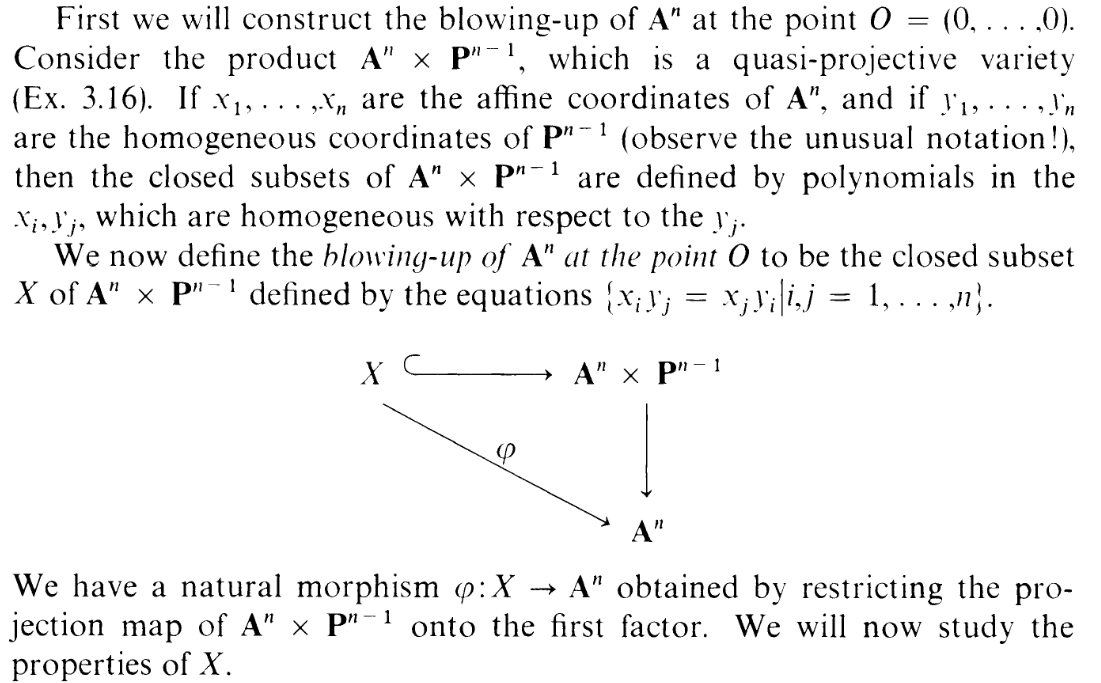I.5.7
8/16/2021

Part a
As I step up to the plate to write this post, I am looking at my weeks-old notes
and learning that I did not record sufficiently my solution to this exercise.
One little realization I remember making is that f is homogenous. "Ummmm,
duh? It's a curve in P2, of course it's homogenous." Well, reader, Ispent days
stuck on this exercise because I wrote f as the sum of its homogenous
components, all like
| f | = f2 + f3 +
 + fn + fn |
Hahahahahahahahaha. Well, of course, it's just
| f | = f2 |
So fuck my ass for wasting days not realizing that. Whatever
| f | = ax2 + by2 + cz2 + dxy + exz + fyz |
So let's review what this exercise is asking us to do. We know that the curve
defined by f in P2 is nonsingular. We want to show that the curve defined by f
in A3 is nonsingular (except at the origin P = (0, 0, 0), which does not exist in
P2). When speaking of affine varieties, we analyze nonsingularity by looking at
the Jacobian, which here looks like
![[2ax + dy + ez 2by + dx + f z 2cz + ex + fy ]](Ip5p71x.png) | (1) |
This is clearly singular at P. Now the exercise wants me to show that it's
nonsingular everywhere else.
Another dumbass mistake I kept making in this exercise is I kept forgetting to use
the fact that P2 is nonsingular... Yeah.
Now, we can't use the ez "Jacobian" definition of nonsingularity on a
projective variety... unless, like back in 5.5, we cover it with open affines. Since
f = 0 is nonsingular in P2, we know that the affine varieties given by
f(1,y,z) = 0,f(x, 1,z) = 0,f(x,y, 1) = 0 in A2 are nonsingular.
But how does this help us in showing that f(x,y,z) = 0 in A3 is nonsingular?
In A3, f(x,y, 1) = 0 is the set z - 1 = 0, which is a closed set. Nonsingularity
can be checked on open subsets, but not necessarily on closed subsets. (since the
local ring is only guaranteed to stay intact on open subsets, and nonsingularity is
essentially determined by the local ring).
Well, let's take a look anyway. We know that f(x,y, 1) = 0, is nonsingular,
right? In other words, the affine variety given by the zero set of
| fz | = ax2 + by2 + c + dxy + ex + fy |
is nonsingular. Since it's affine, we can look at its Jacobian:
![[2ax + dy + e 2by + dx + f ]](Ip5p72x.png) | (2) |
We know this is nonsingular for any point in A2. But we want the Jacobian in
(1) to be nonsingular. Hmmm.
Now let Q = (X,Y,Z) be a point in A3 with Z≠0. Note that our Jacobian (1)
is a gradient vector, so we only care if it has a nonzero component. And, that
Jacobian happens to consist of homogenous polynomials. I.e. we can divide each
coordinate by Z, and that won't change whether or not the component is
nonzero. I.e. we can assume Q = (X,Y, 1) without loss of generality, and thus
plugging it in, we get:
![[2aX + dY + e 2bY + dX + f 2cZ + eX + fY ]](Ip5p73x.png) |
But now if we plug it into the nonsingular (2), we see that the first two components match, so one of the components must be nonzero. Repeat the same argument on the other open sets (X≠0,Y ≠0) and we're DONE.
Part b
 Ooooh, now we get to blowup in three variables!
Ooooh, now we get to blowup in three variables!
| xu | = yt | ||
| xv | = zt | ||
| yv | = zu |
Let d = degf, and consider the open set t≠0 (will be an analogous argument
for the other open sets). Then we get
| xu | = y | ||
| xv | = z | ||
| yv | = zu |
Here's the trick (HADTA LOOK AT LE SOLUTION FOR THIS):
| f(x,y,z) | = f(x,xu,xv) | ||
| = xdf(1,u,v) |
xd = 0 is the exceptional curve, so the blowup (in t≠0) is given by
| f(1,u,v) | = 0 |
But in part a, I already discussed that this curve is nonsingular. DONE.
Part c

Remember the discussion yesterday?(day before
yesterday. I'M A DAY L8 D: ). See above: In this exercise they gave the definition
of ϕ as X → X. So we're again looking at where the exceptional curve intersects
X. Let's blow up again:
| xu | = yt | ||
| xv | = zt | ||
| yv | = zu |
Remember: the coordinates are (x,y,z,t,u,v) ∈ A3 ×P2. Also remember:
The exceptional curve is where x,y,z = 0. And since Y ⊂ P2, the most
natural map I can think of is
| δ : ϕ-1(P) | → Y | ||
| (0, 0, 0,t,u,v) |
 (t,u,v) (t,u,v) |
Wait... Is that.... a delta? ARRRGGGGGHHH I'M GOING INSANE... Delta is spreading, guys. My whole family suffered from covid... MY SON HAD A HIGH FEVER... which sucks, but most kids have had to deal with that... AND MY DAUGHTER... well, she was fine, I guess... BUT STILL... IT WAS SO SCARY. The only person that seriously suffered was our unvaccinated relative, but WE'RE THE VICTIMS. Well, thank God I'm vaccinated and our family has gone through this virus. *Sigh* Now, we can finally move forward.
Stricter measures are in place for our
family moving forward. We continue to wear masks. Until our kids are
vaccinated, we will not allow them around unvaccinated people in any situation.
Some may say they are protected after having the virus, but this is not always
true. My doctor informed me that anyone — vaccinated or not — can get the
virus again after healing from it. The delta variant is spreading fast and furious,
and as a parent, I am terrified of the thought that my kids could possibly
deal with this again. Our kids will be wearing masks this fall in school.
Protip: Ignore my political opinions, I have no idea what I'm talking about. anyway, how do I verify that this is an isomorphism? Err, well it's def a bijection, but that ain't the same thing as "isomorphism" in the category of varieties, eh? The annoying thing is that the structure of A3 × P2 as a variety isn't obvious. Actually, what was it, even?

Ah, all we have to do is look back at 3.16 and... O-oh... *Takes hibiscus out of hair off to respect the 6 million readers lost during The Dark Hour.*

Well, in my notes I did some fancy "open affines" business. Buuuuut, in spite of the information (and readers) lost on 3.16, I think it's faiiiiirly plausible that the set x,y,z = 0 just gives A3 × P2 the structure of P2. Hence δ is essentially the identity and we're done.
Well, the only weird thing is that the same argument applies to any projective variety, doesn't it?